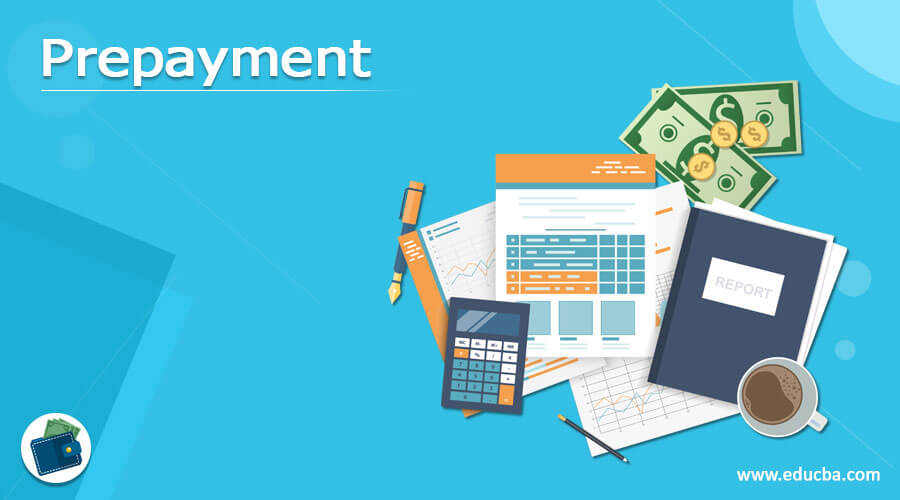Updated July 10, 2023
What is Prepayment?
Prepayment refers to any payment made before its due date. Typically, firms make advance payments to reduce their financial burden, especially for loans. In the case of trading bills, this payment type also serves as a tool for accessing monetary benefits through discounts.
Some of the most common prepayment examples are loan repayment, prepaid bills, salary, rent, insurance premium, income tax, sales tax, credit card bill, line of credit, etc.
Key Takeaways
- Prepayments refer to the payment of expenses well before their actual due date.
- Firms typically make prepayments to reduce their financial burden or utilize it as a financial tool to obtain monetary benefits through discounts.
- There are three types of prepayment – prepayments by corporates, prepayments by individuals, and prepayments by taxpayers.
- On the date of the prepayment, the accountant debits the prepaid expense account and credits the cash account.
How Does Prepayment Work?
A prepayment is a financial tool for people who intend to make the most of a payment obligation. In simple terms, prepayment is the early payment of the future liability. For instance, an insurer may choose to prepay the insurance premium, which will become due next year, or a firm may prepay its supplier well before receiving the consignment.
Besides adjustment of the accounting entries, the firms don’t face too much of a hassle with prepayments. Such payments are captured as current assets in the balance sheet. However, the parties participating in the transactions must agree to the arrangement; otherwise, there will be some prepayment penalties. Especially many lenders charge a penalty if the borrowers decide to repay the loan, making the loan more expensive.
Examples of Prepayment
Let us look at the following examples to understand the concept of prepayment.
Example #1
ABC Inc. paid $24,000 in advance for the marketing and advertising service offered throughout the year. The company will initially charge the entire $24,000 to the prepaid expenses account on the balance sheet. Then it will charge $2,000 of it to the marketing and advertising expense account each subsequent month during the year so that the expense matches its usage. In this case, the prepaid expenses asset will be over by the end of the year.
Example #2
David recently purchased an insurance policy requiring him to charge $500 monthly. He has to pay for at least 6 months of coverage, which he will have to pay $3,000 (= $500 x 6 months) to initiate the insurance service. He will capture the prepaid coverage as an asset in his balance sheet and deduct $500 from that asset every month for the next six months.
Types of Prepayment
There are three main categories of prepayment – prepayments by corporates, prepayments by individuals, and prepayments by taxpayers.
1. Prepayments by Corporates
In this case, prepayments are mostly associated with expenses for goods and services. The firms usually pay these expenses in full in one accounting period for items consumed in the future. Initially, the balance sheet classifies the prepayment as a current asset and later reclassifies it as an expense in the income statement once the asset is consumed.
2. Prepayments by Individuals
Here the individuals make the advance payment, and the accounting process, in this case, is much easier. Examples of prepaid expenses include utility bills, loan installments, credit card bills, etc.
3. Prepayment by Taxpayers
Typically, taxpayers make a prepayment of their taxes wherein part of their pay is withheld for taxes. In the case of salaried employees, their employers withhold the taxes and pay them to the government on the employee’s behalf. On the other hand, self-employed individuals make the prepayment by filing quarterly taxes.
Accounting for Prepayment
It is important to understand the accounting for prepayments under the double-entry book-keeping system, wherein these payments affect both the balance sheet and the income statement. On the date of the advance payment, the accountant debits the prepaid expense account and credits the cash account. Suppose the service associated with the advance payment is likely to be availed of in the same accounting period. In that case, it won’t affect the balance sheet at the end of the accounting period. We incur the prepaid expense in the current accounting period, and the service will be available in the following period. In that case, it will appear as a current asset on the balance sheet for the current period.
Management of Prepayment
In a typical sales process, the buyer places the order for goods or services, and the supplier fulfills the order by shipping the same. The process begins with generating an invoice, followed by sending it for payment and concluding with the buyer receiving the order after the payment is made. In some cases, the supplier receives full payment up-front well before delivering the goods or services, referred to as prepayment.
Conclusion
So, it can be seen that prepayment is a very useful tool that both corporates and individuals can use to reduce their financial burden and get monetary benefits. While corporates must handle the accounting process, individuals don’t need to worry about accounting. So, overall, it can be a great financial tool if used wisely.
Recommended Articles
This is a guide to prepayment. Here we discuss the definition, working, examples, types, and accounting for prepayment and prepayment. You may also have a look at the following articles to learn more –


